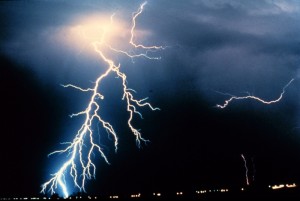 We had a few close bolts of lightning during last evening’s thunderstorm. One of the bolts caught fire to a neighbor’s backyard shed. It was one of the scarier lightning storms I’ve experienced.
We had a few close bolts of lightning during last evening’s thunderstorm. One of the bolts caught fire to a neighbor’s backyard shed. It was one of the scarier lightning storms I’ve experienced.
I decided to look up some info on lightning today and came across this PBS page written by a lighting expert. Dr. David Dwyer, Associate Professor of Physics and Space Sciences at Florida Institute of Technology, answers questions about lightning. I found this Q&A particularly intriguging.
Q: Within the NOVA Web site I read that lightning heats the surrounding air of a lightning bolt to ~50,000°F, or hotter than the sun. The sun, as I understand it, generates heat through fusion reactions. So why don’t we see fusion reactions taking place within the surrounding air of a bolt of lightning? Casey, La Jolla, California
The surface of the sun is about 10,000°F, which is much cooler than the hottest part of lightning. However, the nuclear fusion that powers the sun occurs only near the center where the temperatures are much higher (30 million°F) and the pressures are very large. In comparison, lightning is downright chilly. As a result, no nuclear reactions are expected to take place during lightning. Having said all this, several independent research groups have recently measured nuclear by-products associated with lightning, which according to our standard picture doesn’t seem possible. If these results are correct, then something very unusual is happening with lightning—so stay tuned.
I did more poking around and found some articles of studies that seem to show that lightning can produce gamma rays. Those bolts may also be hurling antimatter into space! Fascinating!